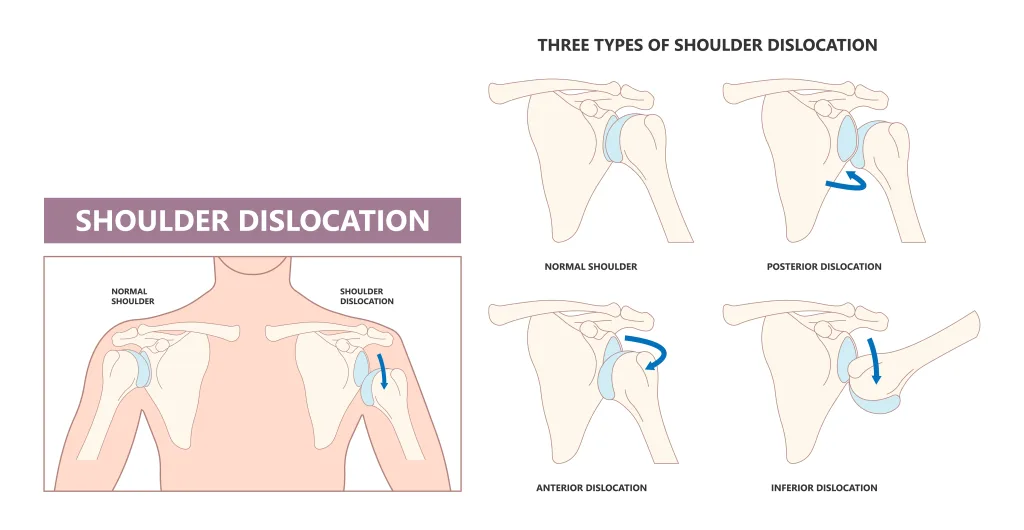SHOULDER DISLOCATION
- Home
- SHOULDER DISLOCATION


What is a Dislocated Shoulder?
A dislocated shoulder happens when the head of the upper arm bone (humerus) is forced fully or partially out of its normal position on the shoulder socket (glenoid). A full shoulder displacement means it is all the way out of the socket. A shoulder displacement normally correlates with severe discomfort or pain and an inefficiency to move your shoulder till it is located at the right position back into the socket. Displacements of a shoulder in a young person correlate with sports games (basketball, football, and volleyball) or falls. An older person inclines to dislocations because of a continuous weakness of the ligaments and shoulder joints.
What Are Dislocated shoulder Symptoms and Signs?
Dislocated Shoulder may also begin infirmity or weakness near the damage, such as in the neck or rest your arm. The tissues in your shoulder may pain from the disturbance, often raising the severity of your pain.
The main indication of a Dislocated shoulder is a critical pain in the affected shoulder joint.
The sufferer will have big difficulty to move affected arm even a small portion.
If the shoulder is touched from the side, it feels muddy, as if the underlying bone is gone usually the humeral head top of the shoulder arm bone is displaced below and toward the front and there is often a physical abnormality.
The sufferer may feel like the arm is free, and they may catch pops sounds or clicks on the shoulder.
Dullness, tingling, and deficiency in the shoulder may happen in the injured upper arm.
In serious damage, there may be blistering or bruising of the area.
Causes of dislocated shoulder
The shoulder joint is the most displaced part of the body because it flows in different directions. Your arm can disengage foremost, rearward or downwards, totally or somewhat, though most displacements happen due to the head of the shoulder. In addition, fibroid muscle that connects the osseins of your shoulder can expand or split, often involving the displacement. A dislocated shoulder can happen more quickly in persons who are highly adjustable or flexible, such as those with free the shoulder joints.
A shoulder dislocation caused by:
Falls or slip- Shoulder dislocation happens when you fall based on your shoulder, such as from a stairway or slipping on a loose drag.
Injuries not related to sports games. A strong hit to your arm through a motor vehicle disaster is a basic cause of displacement.
By Sports games damages. A dislocated shoulder is a general trauma in meeting sports games, such as soccer, hockey, and in sports that includes drops or slips, such as downhill skiing, aerobics, Rugby.
Treatment For Dislocated Shoulder
The goal of the primary therapy of a dislocated shoulder is to decrease the dislocation pain and relocate the humeral to its normal place in the glenoid. There are many kinds of treatment method that will apply to complete this goal.
Hennepin maneuver
In this method the sufferer resting flat position or lying, the surgeon turns the elbow to 90 degrees and slowly twists the arm in external rotation. Tissue seizure is capable to overwhelm after 5 to 10 minutes of soft pushing, allotting the shoulder to instinctively relocate. The Milch method adds soothing lifting of the shoulder over the head to achieve compression.
Scapular manipulation
The sufferer may be resting up or lying recumbent. An orthopedic specialist tries to twist the shoulder blade, pushing the humeral head, and allotting natural relocation. An assistant requires maintaining the arm.
Traction-counter traction
In this type of treatment the sufferer lying plane position, a layer is bent around the armpit. While the Doctor stretches down on the shoulder, a helper placed at the head of the couch pulls on the layer to implement counter friction. As the tissues repose, the humeral head is able to return to its natural state.
Open reduction
In exceptional cases, the shoulder cannot be settled using closed-door conversion methods because a muscle, ligament, or part of cracked bone gets taken in the joint, barring a return of the humeral head into the glenoid. When closed-door conversion fails, it requires an orthopedic doctor to conduct an operation or surgery.
Recovering from a dislocated shoulder:
You can normally go back to home shortly after your shoulder joint placement back in right place. So, you need to your shoulder in a bandage for a starting few days while the pain ends. A doctor can prescribe some kind of arms & shoulder exercises.Therefore, these will help to reduce the pain, stiffness and increase the strength of shoulder joint.
In conclusion, Get the expert advice from the shoulder specialist doctor.
Call Us Today for Consultations
Feel free to pay us a visit. You won’t regret it for sure.










